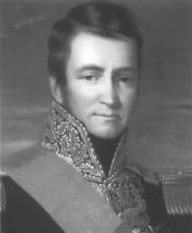General Joseph Rogniat

Born: November 9, 1776
Place of Birth: Saint-Priest, Isère, France
Died: May 8, 1840
Place of Death: Paris, France
Arc de Triomphe: ROGNIAT on the west pillar
Pronunciation:
The son of a notary, Joseph Rogniat originally studied at the college of Oratoriens of Lyon before he entered the engineering school at Metz in September of 1794 as a sous-lieutenant. In 1795 he was promoted to lieutenant and he joined the Army of the Rhine. Rogniat served at Landau and then in April of 1796 he was promoted to capitaine. That November he served at the defense of Kehl. Rogniat joined the staff of engineers of the Army of England in January of 1798 and over the following years he served with the Army of Mainz and the Army of Switzerland before ending up with the Army of the Rhine. In June of 1800 he fought at Neubourg and he became an aide-de-camp to General Grandjean. A month later Rogniat was promoted to chef de bataillon and then in November he took command of the engineers of the center corps under Moreau. In December he served at the Battle of Hohenlinden.
In 1801 Rogniat was sent to command the engineers at Belle-Île-en-Mer and later that year he was named deputy director of fortifications of Lyon. In 1803 he was sent to the camp of Bayonne and then to Brest. After the campaign began in 1805, Rogniat took command of the engineers of Marshal Augereau's VII Corps. The next year he took command of the engineers of the cavalry reserve under Marshal Murat. Rogniat served at the Battle of Jena, Pultusk , and the Battle of Eylau. In March of 1807 he joined Marshal Lefebvre's X Corps and he went on to serve at the Siege of Danzig . That July Rogniat served at the Siege of Stralsund.
In 1808 Rogniat was promoted to colonel and assigned to the staff of the Army of Spain. In September Napoleon designated Rogniat to be second in command of the engineers at the Siege of Saragossa. Rogniat served at Tudela in November, at the action of Madrid in December, and then he returned with the French to lay siege to Saragossa again. After General Lacoste was killed in February of 1809, Rogniat became commander-in-chief of the engineers at the siege. After the conclusion of the siege, Rogniat returned to France where he was promoted to général de brigade and then he took command of the engineers of II Corps of the Army of Germany under Marshal Lannes. He took part in the campaign against Austria and he served at the Battle of Aspern-Essling and the Battle of Wagram . That December he was named a Baron of the Empire and then sent back to Spain.
In Spain Rogniat was assigned to command the engineers of the Army of Aragon under General Suchet. In April of 1810 he directed the Siege of Lérida and in 1811 he directed the Sieges of Mequinenza, Tortosa, and Tarragona. After these successes Rogniat was promoted to général de division. In October of 1811 he served at the Battle of Sagonte and he went on to serve at the Sieges of Murviedro and Valencia. In 1813 Rogniat was recalled to France to join the Grande Armée during the campaigns in Germany. He served at Lützen, Bautzen, Dresden, Leipzig , and Hanau. For the defense of France of 1814, Rogniat directed the defense of Metz.
After Napoleon's abdication and the Bourbon Restoration, Rogniat was named a Knight of Saint Louis and he continued to be employed. Nevertheless, when Napoleon returned from exile in 1815 for the Hundred Days, Rogniat continued to serve France and was placed as commander-in-chief of the engineers of the Army of the North. He served in Belgium that June and took part in the Battle of Waterloo. After the loss of the battle, he returned to Paris and was relieved by Marshal Davout and he did not join the army on the Loire.
Rogniat went on to publish a number of works on the art of war, some of which Napoleon read on Saint Helena and disagreed with. Marbot wrote refutations that criticized Rogniat's writings.1 Rogniat married the daughter of Marshal Pérignon in 1826.
Notes
Bibliography
- Divry, Arnauld. Les Noms Gravés sur l'Arc de Triomphe. Paris: L'Harmattan, 2017.
- Six, Georges. Dictionnaire Biographique des Généraux & Amiraux Français de la Révolution et de l'Empire (1792-1814). 2 vols. Paris: Gaston Saffroy, 2003.
Updated April 2018
© Nathan D. Jensen